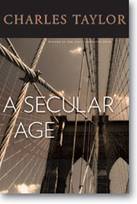
A Secular Age. By Charles Taylor. Harvard University Press, 2007. 874 pp. $39.95
That we live in a secular age is a fact that few can doubt. For individuals in modern Western society, belief in God has become one personal choice among many, roughly analogous to belief in a given political issue; some rally behind it, others vigorously oppose it, while still others remain more or less indifferent. And yet, less than five hundred years ago it was virtually impossible not to believe in God. So what happened? This is the question which Charles Taylor seeks to answer in his magisterial A Secular Age. In this lengthy volume Taylor explores the myriad of historical, ideological, and social conditions which led to the radical shift whereby secularism replaced religious belief as the “forgone conclusion” of Western society. Taylor, a Canadian philosopher, recently won the Templeton prize for research regarding spiritual realities, which began with his 1999 Gifford lectures entitled Living in a Secular Age? and culminated in the publication of A Secular Age in 2007. The book is divided into five sections; the first three consist of an historical narrative which provided the basis for his 1999 Gifford lectures, while the final two sections deal with more contemporary matters, which Taylor had wanted to discuss in his Gifford lectures, “but lacked the time and competence to treat properly” (ix). Consequently, the following review will be divided into two parts, the first dealing with sections I-III and the second with sections IV-V.
Part I
The first three parts of the book chart an historical narrative of secularization as it developed over the past five centuries. In the first section, The Work of Reform, Taylor explicates the pre-modern “enchanted” worldview, and its gradual transformation via the Reformation and early Enlightenment. Section two, entitled The Turning Point, focuses on the rise of “Providential Deism” and concomitant decline in the ascendancy of transcendence during the 18th and early 19th centuries. The third section, entitled The Nova Effect, considers the immense proliferation of potential worldviews that accompanied the rise of “exclusive humanism” during late Modernity, as well as the bleakness of a world bereft of transcendence.
Perhaps the first thing to note about Taylor’s historical investigation is its indirect and multifaceted methodological approach. Thus before diving into the narrative itself, it might be helpful to elucidate the following three approaches which undergird Taylor’s dense study. Firstly, Taylor prescinds from a purely theoretical study, opting instead for a phenomenological investigation. While a theoretical study approaches the subject matter on an abstract conceptual level, a phenomenological methodology proceeds by way of description of embodied experience: “I want to talk about belief and unbelief, not as rival theories, that is, ways that people account for existence, or morality, whether by God or by something in nature; rather what I want to do is focus attention on the different kinds of lived experience involved in understanding your life in one way or the other, on what its like to live as a believer or an unbeliever” (5). This method greatly influences Taylor’s historical analysis and will recur in the discussion of social imaginaries below.
Secondly, Taylor’s narrative approach, though historical, is more circuitous than linear. His arguments consist of intricate themes which weave in and out of historical epochs, often intertwining with seemingly unrelated subjects. As Taylor guides us through this elaborate narrative, he utilizes historical illustrations which serve to clarify his arguments while at the same time giving them fuller depth and complexity. Indeed, it often seems as though the main argument is occurring beneath the surface, grounding the historical illustrations and explaining their various movements and interconnections, like the riverbed which determines the contours and currents on the river’s surface.
Finally, on a more technical note, Taylor maintains a dialectic between two contrasting interpretations history, that of historical materialism and idealism. The former, deriving from Marx, understands material conditions, especially economic conditions, to be the driving force of history; thus every societal institution, including religion, can be explained in terms of economic forces. Idealism, usually associated with Hegel, takes the opposite approach, seeing ideas as the independent and driving force of history. Taylor situates himself between these two extremes, insisting that a close examination of history reveals not an either/or between ideal and material forces, but a both/and. That is to say, historical occurrences are not wholly reducible to one or the other, for these forces are “often quite inseparable” (212).
Taylor begins his study with the present day phenomenon of secularity, which simply stated means that religious belief is no longer a given in western society. Though resisting the idea that Modernity brings about the death of God by necessity, Taylor does concede that it precipitates the death of religious naiveté. This naiveté refers not to the content of religious beliefs per se, but rather to belief in the transcendent in general. To have lived prior to the 16th century meant inhabiting a naive world, a world in which unbelief was unimaginable for the vast majority of people. To live in modern western society where “naiveté is no longer available to anyone” means that those even those who hold religious beliefs are aware of unbelief as a live option” (21). Even those who may be unable to imagine life apart from their religious tradition are aware of the fact that countless people live productive lives without religious faith. Hence for modern western society religious belief is no longer a forgone conclusion but rather one way of life among many others.
Before attempting to trace the decline of religious belief through western history, Taylor situates his approach in contradistinction to the one-dimensional, oversimplified accounts which he calls “subtraction stories.” Accounts of this sort involve “subtracting” religious belief from a given worldview, inevitably resulting in a more fully human outlook, one liberated from dogma and illusion. Not only are subtraction stories superficial when set against the complexity of history, but they also presuppose a kind of essentialism in respect to human nature, explaining the decline of religious belief as the advancement of the essential features of human nature which “were there all along” but had been covered over and obstructed by the religious dogma and illusion which are now discarded (22).
The inadequacy of subtraction stories leads to another of the book’s important themes, what Taylor calls “background understandings.” Drawing upon Wittgenstein’s notion of “forms of life” and the Heideggerian conception of “horizons of understanding” Taylor argues that no form of human understanding or practice is intelligible without a “background understanding” which situates the individual and provides a context of meaning for intentional acts. Because background understandings are the condition of possibility for meaningful acts, they remain for the most part tacit and assumed as a matter of course. We might liken background understandings to the whiteness of a page, which provides the background for the black ink to stand out against, and the condition of the spatial difference between letters, though it remains more or less inconspicuous to us.
In similar fashion, Taylor employs what he calls “social imaginaries” which function more or less like background understandings, with the exception that social imaginaries are inherently common to a large group of people. Taylor describes social imaginaries as the ways in which people “imagine their social existence, how they fit together with others, how things go on between them and their fellows, the expectations which are normally met, and the deeper normative notions and images which underlie these expectations” (171). Hence, much like background understandings social imaginaries are usually assumed as a matter of course. Taylor is careful to distinguish social imaginaries from social theories, since the former is refers to the way in which “ordinary” people understand and comport themselves within their social milieu. Thus social theories and social imaginaries are “not at all the same thing” because many theoretical developments have little to no effect on our social imaginary (325). Given the fundamental importance of background understandings and social imaginaries, we may now better understand why Taylor finds subtraction stories to be so inadequate. Subtraction stories are more or less one dimensional, failing to take into account the array of factors which constitute background understanding, and the way in which background understanding constitute the norms of what is conceivable or plausible.
The notions of background understandings and social imaginaries lead back to Taylor’s historical narrative, beginning with 16th Century Europe. Taylor calls attention to the well-known but perhaps underestimated fact that the western world of the 16th Century was an “enchanted world” filled with spiritual forces, both good and evil; demons, angels, spells and incantations, holy relics containing spiritual power, etc. All of these constituted the “enchanted” background understanding for individuals during this time period. Due to the host of spiritual and magical forces abounding, Taylor notes that disbelief in God is hard, if not impossible for most individuals living in the enchanted world (41). Without the protection of some powerful spiritual force, viz. God, the individual is vulnerable to malevolent spirits of all kinds. Taylor contends that the individual in the enchanted world may be characterized as a “porous self,” that is, a self which is open to the influence of spiritual forces, i.e. demon possession, miraculous healing, etc. In contrast, those who inhabit a “disenchanted world” (and thus operate under a different background understanding) see themselves as autonomous agents, protected less by God than by the principle of causality, which renders them impervious to the influence of supernatural forces.
Taylor understands the Reformation as the historical event which sparked the “disenchantment” of the world. This was largely due to the shift from an objective religious framework (e.g. the sacraments, the Church as the repository of absolute truth, the pope as the vicar of Christ, etc) to a subjective framework (e.g. salvation by subjective appropriation of Grace through faith, Luther’s notion of the “inner man” etc). Taylor observes that along with the subjective shift of the Reformation comes the abolition of the sacred, especially as seen in the rejection of transubstantiation in respect to the Eucharist. Grace is no longer mediated via the objective presence of the body and blood of Christ, but rather through the subjective response to the Word. While the medieval Church offered what Taylor calls “white magic” to combat and counteract the “dark magic” of the enchanted world, the Reformation renders all magic dark (80). Thus before the rise of Enlightenment rationality, the Reformation takes the first step towards disenchanting the world. Taylor observes that, “disenchantment, Reform, and personal religion went together” (146).
Taylor understands the 17th and 18th centuries as laying the groundwork for what he calls “exclusive humanism,” a social imaginary in which all human values and concerns are understood without reference to the transcendent. Through the Protestant disenchantment of the world and the rise of the individualism, the “buffered self” begins to emerge. Descartes, Locke and later Kant will add to this buffered self the key components of autonomy and agency. The central notion of Natural Law develops alongside the autonomous subject, which significantly contributes to shifting the gravity of life away from the supernatural and towards the individual and the natural order. It is not long before the notion of Deism becomes more and more conceivable within the modern social imaginary. Descartes prefigured this shift in his Meditations, where he drew upon the idea of God to guarantee his rationality. In like fashion, there arises in the 18th century the notion of a wholly Transcendent God who guarantees the natural order of things, but in no way interferes with this order, vis a vis miracles. Equipped with rationality and the natural law (what Taylor calls the “immanent order”) individuals are grateful to the Providence of God, but remain more or less reliant upon themselves. Taylor notes that along with the rise of Deism and the immanent order, comes the eclipse of Grace. While for Luther the individual cannot achieve righteousness without the grace of God, the “buffered self” can pull itself up by its own bootstraps as it were. Given the rise of the individual as autonomous agent and the natural (immanent) law, “The highest goals had to be brought down into the human realm, as it were, ends beyond human flourishing had to fade from view” (261).
Taylor cites the quasi-autonomous humanism of Providential Deism and the immanent order as the key to understanding the transition from the pre-modern ubiquity of religious belief to the eventual rise of “exclusive humanism” during the 19th century. The Protestant disenchantment of the world along with the rise of autonomous individualism and the natural law are essential to the shift towards immanence occurring within background understanding of modernity. It is only with the security provided by this background understanding that the notion of “exclusive humanism” could become conceivable within western society. This gradual but nevertheless radical shift leads to what Taylor calls the “nova effect,” whereby the security and autonomy of the buffered self gives rise to an “ever-widening variety of moral/spiritual options” (299). It now seems as though the buffered self inhabits a world of limitless possibilities.
There is however, a flip side to this story. Taylor notes that the shift from the porous self to the buffered self is not a total victory for rational agency. There is indeed something lost. The very danger faced by the porous self (its openness to reality, its vulnerability to being affected by mysterious forces) becomes the “malaise” of the buffered self. That is to say, the buffered self is so insulated by rationality that nothing other, or mysterious can affect it or stand out for it (303). The disenchanted world eventually gives rise to a world bereft of any mystery or meaning; the world becomes an object to be manipulated by rational instrumentality. While the central problem for the porous self was an “excess of meaning” (supernatural forces, demons, etc.), the issue facing the modern individual is a lack of meaning, what Taylor refers to as the “malaise of immanence” (309). It was precisely this phenomenon which the Romantics reacted against. With this in mind Taylor cites Schiller’s poem The Gods of Greece, in which he bemoans, “A Nature shorn of the divine” (317). The rising problem of meaninglessness goes hand in hand the final upshot of the “nova effect,” namely the rise of atheism (or unbelief) as a live option. In light of this “malaise of modernity” we may better understand Nietzsche’s madman who proclaims not only that, “God is dead”, but that it is we who have killed him.
Part II
As evinced by the length of this review, A Secular Age is a substantial book that requires some time and concentration to get through. Part IV, Narratives of Secularization, is broken up into three chapters, The Age of Mobilization, The Age of Authenticity, and Religion Today. Through these chapters, Taylor explains the vital concepts that have controlled religion and society during the past seven centuries. The Age of Mobilization illustrates the glory days of the “Ancien Régime” when religious hierarchy ruled the nations and political figures were venerated as divine appointees. And, consequently, Taylor illustrates that the end of the glory days of the “Ancien Régime” were followed by the “Age of Mobilization” which was driven by moral ideals and the desire for personal spirituality. In the The Age of Authenticity, Taylor explains the pros and cons of the “pursuit of (individual) happiness” (484). In the final chapter of part IV, Religion Today, Taylor draws on the western phenomenon of being “spiritual but not religious” (535). Part V includes six chapters, The Immanent Frame, Cross Pressures, Dilemmas 1, Dilemmas 2, Unquiet Frontiers of Modernity, and Conversions. In Part V, Conditions of Belief, Taylor delves more deeply into the world that often conflicts with religion, particularly science, materialism, sexual pleasures, and violence.
Throughout the chapters, Taylor uses the terms, neo-Durkheimian, paleo-Durkheimian, and post-Durkheimian. These terms are meant to illustrate the relationship between the church and the state. In a neo-Durkheimian culture, people make their own moral decisions in relation to their church life; for example, they choose to join a denomination “because it seems right” to them (486). In paleo-Durkheimian cultures, people are forced to integrate into the religion of the state; they are “connected with God against their will” (486). Post-Durkheimian culture is what Taylor calls the mode of today; similar to the neo-Durkheimian, people have the right to choose their own church, but in post-Durkheimian cultures, “joining a church you don’t believe in seems not just wrong, but absurd” (489). Taylor quotes a post-Durkheimian speaker at a New Age festival as saying, “Only accept what rings true to your own inner Self” (489).
Taylor tackles some tough philosophical issues, like that of Nietzsche’s “death of God” and Weber’s end of the “Enchanted World.” The “death of God” and science’s refutation of religion have left society with nothing to believe in. People have lost the ability to love and have devotion for a God that Taylor says sometimes “just seems obvious” (569). This atheistic, “modern humanist culture,” faces four major problems; first, to agree with Nietzsche’s “death of God” means that “one can no longer, honestly, lucidly, sincerely believe in God”; second, the rise of “subtraction stories” of modern humanism has eliminated the mythical stories that have thus far defined humanity; third (and I would say most importantly) “religion simply becomes unnecessary when technology gets to a certain level: we don’t need God any more, because we know how to get it [anything that we need] ourselves”; and finally, forth, religion is simply suppressed by science, creating the gradual recession of religion in the modern secular age (573-4). This all leads to the end of the “Enchanted World”. In the 1500s, God was everywhere and the world was “enchanted”; it was full of hope and security (25). But the modern world is “Disenchanted”; it is a “world without meaning” (680). The “disenchanted world” is a world without hope or purpose; the evils of the world are overwhelming and without a sense of God there is no protection from the “loss, dispersal, evil, blindness, dullness, emptiness, [or] flatness” (681). The reactions to the “disenchanted world” are either to shut the world out and turn off the news, or to become part of the solution and to do something to “heal the world.” Taylor’s solution is exemplified in “those who connect themselves to God” like Mother Theresa of Calcutta, who serves as an example of love and hope in the “disenchanted world” (684).
Taylor also tackles some hot topic issues, or dilemmas, such as sexual pleasures and violence. He refers to Hugh Hefner several times, and not in a negative way. His point is that the roots of asceticism and self-denial in Christianity have deprived the faithful of even healthy sexual relationships. He explains that, “what we call today sex and violence could also be ways of connecting to the spirits/gods or higher world” (612). Some people have “rejected Christianity altogether” because it sacrifices “the joys of ordinary sensual, bodily existence in the name of illusory ideals of abstinence and renunciation” (627). Thus the neglecting of natural desires (Taylor differentiates the natural from the promiscuous) causes people to reject religion. The second dilemma is that of violence. Taylor explains that the problem with mixing religion and violence is that far too often, religious people think that God is on their side, and that their violence is justifiable because they are doing the will of God. Seeing this as a flaw in the ideals of the religious, Taylor challenges Christians to use the “Gospel picture” to form “Christian counter-violence” (708). He proposes talking over fighting, and commends Nelson Mandela for creating space for the good to triumph in the Truth and Reconciliation Commission in South Africa (705-7). Taylor also proposes two necessities to overcome violence; first, non-violence must be ordered by “democratic polities”; and second, “try to make their [democratic] benefits spread as wide as possible, e.g., by preventing the formation of desperate, excluded groups; particularly young men” (708). Taylor’s presupposition is that equality will lead to peace, and by not ostracizing any groups, there will be no need to fight or rebel.
Conclusion
There is great difficulty in forming a personal response to a work of such breadth and complexity. Such effort is further complicated by Taylor’s highly nuanced, somewhat idiosyncratic style of argumentation. A Secular Age is a rich tapestry, and to appreciate it one must enter into its elaborate network and follow through its intricately woven arguments. And it is precisely this aspect which makes it so difficult to extricate oneself from within Taylor’s “story” and comment on it as a whole. A Secular Age is thus highly resistant to general summarization and perhaps even more so to broad criticism. The only general critique that seems warranted is that of Taylor’s academic idiom. Aside from occasionally using technical philosophical terms without defining them, he often cites quotations in French, German and Latin without offering a translation. This criticism aside, we respectfully leave any major critique to the professional philosophers, whose learning would be adequate to such a task. Hence in place of a general critical assessment, we shall conclude with a general observation regarding the work. It might be argued that we may understand Taylor’s complex method as part of the message itself. Taylor’s indirect, intricate and sometimes confusing methodological approach seems to coincide with one of the chief points he argues for, namely the importance of recognizing the complexity of things, and refusing to accept oversimplified generalizations, such as those of the subtraction stories he so despises.
Andrew Linscott (Part I)
Elizabeth Keyes (Part II)
Boston University
Spring 2009



